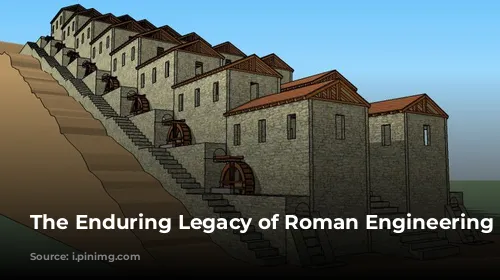Have you ever wondered how the ancient Romans built such impressive structures? From the towering Colosseum to the majestic Pantheon, their architectural feats continue to astound us today. While Julius Caesar may be the most famous name in Roman history, it was his successor, Augustus, who ushered in the Pax Romana (Roman Peace), a golden age of art and technology that lasted over two centuries. During this era, Roman engineering flourished, leading to innovations that improved the lives of Roman citizens and influenced the world for centuries to come.
The Roman City: A Marvel of Engineering
The city of ancient Rome was founded on the banks of the Tiber River. However, the river’s water wasn’t safe to drink, a problem that worsened after the construction of the Cloaca Maxima, a vast sewer system designed to channel waste away from the city. This impressive feat of hydraulic engineering, begun in the sixth century BC, played a crucial role in improving public health in Rome. It’s no surprise that the German historian Barthold Georg Niebuhr compared it to the pyramids, highlighting its massive scale and engineering complexity.
The Secret to Roman Concrete’s Strength
Roman engineers were masters of their craft, and their choices of building materials were no exception. While their concrete was weaker than modern concrete, it was remarkably durable. Structures like the Colosseum, Pantheon, and Pont du Gard have withstood the test of time for almost two millennia. The key to this resilience lies in the unique formula of Roman concrete, which included volcanic ash. During the reign of Augustus, builders experimented with different mortar recipes, ultimately settling on a blend of limestone and volcanic sand from the Pozzolane Rosse, a volcanic ash deposit near Rome. This unique mixture contributed significantly to the longevity of Roman structures.
The Power of Aqueducts
To meet the city’s demand for clean water, the Romans developed a sophisticated system of aqueducts. While not the first to use aqueducts for irrigation, the Romans perfected the design. These systems consisted of underground pipes and above-ground bridges that carried water from lakes and streams in the surrounding countryside to the city. Gravity was the driving force behind this remarkable engineering feat, transporting water across miles of terrain, sometimes from locations as far as 60 miles away. This innovative system supplied fountains, latrines, and bathhouses throughout Rome.
The Science Behind the Arches
The iconic arches featured in Roman aqueducts and bridges are not just aesthetically pleasing; they are a testament to the ingenuity of Roman engineering. Arches allow for the construction of large spans using minimal materials, thanks to the principles of Newtonian physics. Voussoirs, wedge-shaped stones, interlock and push against vertical loads, creating an outward, diagonal force (thrust) that can be counteracted by buttresses. Roman engineers skillfully arranged segmental arches in rows, ensuring they supported each other and transferred forces to stone or concrete abutments.
Building with Practicality: The Roman Approach
What was the secret to the impressive architectural achievements of ancient Rome? It wasn’t advanced mathematics like the Pythagorean theorem, which was developed by the ancient Greeks. Instead, the Romans relied on practical rules of thumb. They understood the importance of compression forces over tension forces when building arches and domes, even without a full grasp of the underlying physics. This practical approach led to the construction of some of the world’s most enduring structures.
The Domed Masterpieces: Pantheon and Colosseum
The famed domed structures of ancient Rome, such as the Pantheon and the Colosseum, employed the same principles used in aqueducts. Vertical loads were supported by the lower parts of the structure, pushing back against them. To compensate for tension forces that could flatten the dome, engineers used lighter concrete at the top of the dome and added stepped rings for reinforcement. They also incorporated blind arches in the Pantheon’s massive walls.
The Pantheon, with its 20-foot-thick walls, featured a central oculus that illuminated the interior with natural sunlight. When the Italian sculptor Michelangelo visited the Pantheon, he was so impressed by its design that he said it was the work of angels, not men.
Modern Engineering and Ancient Wisdom
Today, engineers have access to sophisticated tools and technologies, including computer-generated models and simulations. However, these tools are only as effective as the professionals who use them. Engineers need in-depth knowledge and strong skills to successfully apply these technologies. The University of Texas at Austin offers online engineering programs designed to cultivate the next generation of engineering leaders and innovators.
Embrace the legacy of Roman engineering and embark on your journey towards becoming a skilled engineering professional!
